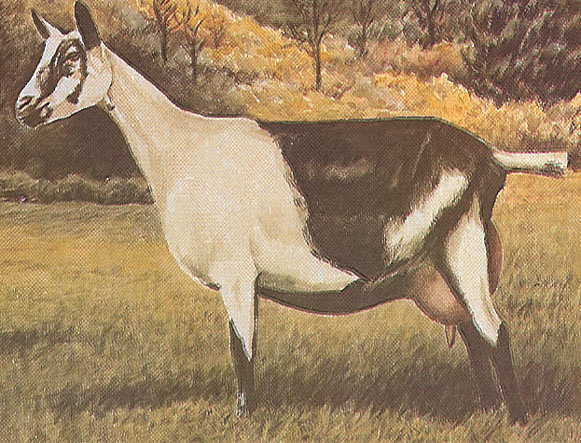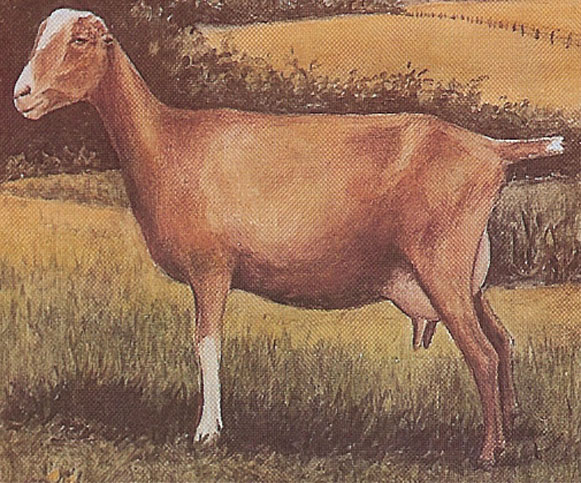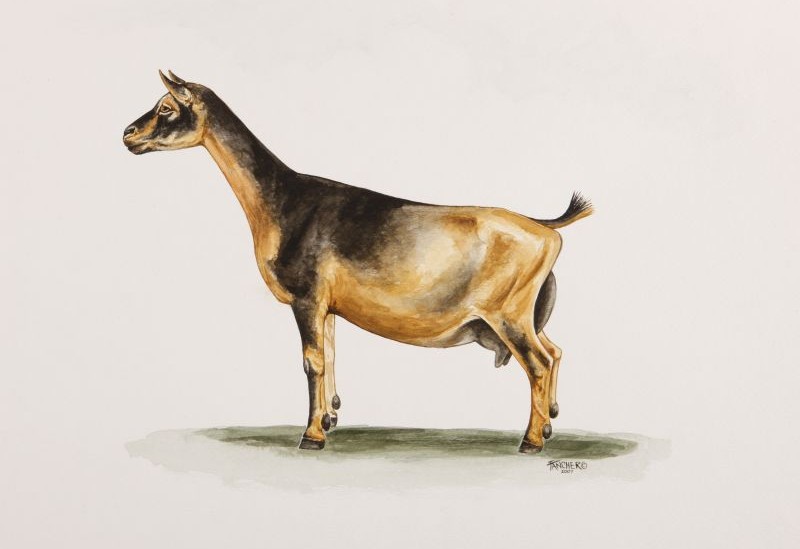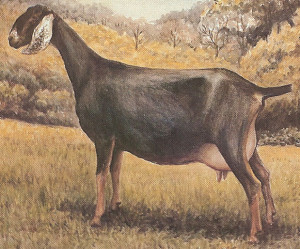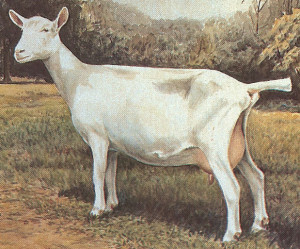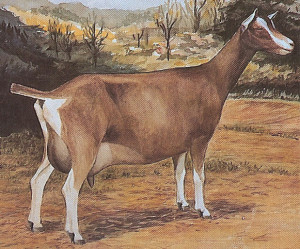Looking to get into dairy goats, but not sure where to start? Well, one good place to start is which breed. There are eight different breeds recognized by ADGA (American Dairy Goat Association). Each has their own strengths and weaknesses, looks, and temperaments.
So here is a list of all the different dairy breeds:
Alpine
Breed characteristics:
erect ears
medium to large size
come in a variety of colors
cannot be all white or have Toggenburg markings
straight face profile
Pros:
a good all-around producer
Cons:
just a typical dairy goat - nothing very unusual about them
famed for being energetic and jumping fences
Other facts about the breed:
I have Alpines and love them!
Swiss (originated in the Swiss Alps)
registered as either American Alpine or French Alpine - French means they are purebreds directly related to those imported. American means that other breeds have been introduced into their lines along the way (also called "breeding up")
So here is a list of all the different dairy breeds:
Alpine
Breed characteristics:
erect ears
medium to large size
come in a variety of colors
cannot be all white or have Toggenburg markings
straight face profile
Pros:
a good all-around producer
Cons:
just a typical dairy goat - nothing very unusual about them
famed for being energetic and jumping fences
Other facts about the breed:
I have Alpines and love them!
Swiss (originated in the Swiss Alps)
registered as either American Alpine or French Alpine - French means they are purebreds directly related to those imported. American means that other breeds have been introduced into their lines along the way (also called "breeding up")
LaMancha
Breed characteristics:
little to no ears
straight face profile
any coloring is acceptable
medium to large size
Pros:
usually easy-going, quiet, and happy to stay in their fence
Cons:
no ears! (though I guess this may only throw some off...)
Other facts about the breed:
originated in Oregon, though they can be traced even farther back, to Spain
LaMancha
Breed characteristics:
little to no ears
straight face profile
any coloring is acceptable
medium to large size
Pros:
usually easy-going, quiet, and happy to stay in their fence
Cons:
no ears! (though I guess this may only throw some off...)
Other facts about the breed:
originated in Oregon, though they can be traced even farther back, to Spain
Nigerian Dwarf
Breed characteristics:
small size
erect ears
any coloring is acceptable
straight or dished face profile
very stocky
Pros:
can milk almost as much as some standards, on less food
easy keepers (they don't need much food to keep weight on)
hardy
high butterfat content
sometimes considered dual-purpose - producing both milk and meat
only breed to have moonspots
Cons:
fence jumpers (or at least mine are!)
very hard to control on the milk stand - they hate being milked or having their hooves trimmed!
sometimes easy keepers can get out of hand and result in fat goats
most have a quite bratty and uppity temperament (some actually think of this as a plus - don't ask)
Other facts about the breed:
originated in Africa
often have more than three or more kids in one kidding, and usually have no problems raising them
often confused with the Pygmy goat (a pet breed)
Nigerian Dwarf
Breed characteristics:
small size
erect ears
any coloring is acceptable
straight or dished face profile
very stocky
Pros:
can milk almost as much as some standards, on less food
easy keepers (they don't need much food to keep weight on)
hardy
high butterfat content
sometimes considered dual-purpose - producing both milk and meat
only breed to have moonspots
Cons:
fence jumpers (or at least mine are!)
very hard to control on the milk stand - they hate being milked or having their hooves trimmed!
sometimes easy keepers can get out of hand and result in fat goats
most have a quite bratty and uppity temperament (some actually think of this as a plus - don't ask)
Other facts about the breed:
originated in Africa
often have more than three or more kids in one kidding, and usually have no problems raising them
often confused with the Pygmy goat (a pet breed)
Nubian
Breed characteristics:
long, drooping ears
Roman nose
medium to large size
any coloring is acceptable
Pros:
some think the ears are appealing
high butterfat content (though not quite that of the Nigerian)
Cons:
famed for being loud
Other facts about the breeds:
most well-known and popular breed in America
originated in Africa
a true Nubian's ears touch in front of the nose
Nubian
Breed characteristics:
long, drooping ears
Roman nose
medium to large size
any coloring is acceptable
Pros:
some think the ears are appealing
high butterfat content (though not quite that of the Nigerian)
Cons:
famed for being loud
Other facts about the breeds:
most well-known and popular breed in America
originated in Africa
a true Nubian's ears touch in front of the nose
Oberhasli
Breed characteristics:
erect ears
straight or dished face profile
brown with black trim (or, in dairy goat lingo, chamoisee)
can also be black, but bucks that are black cannot be registered, only does
medium size
Pros:
a good, typical, hardy goat
Cons:
little to no variety in coloring
Other facts about the breed:
Swiss
Oberhasli
Breed characteristics:
erect ears
straight or dished face profile
brown with black trim (or, in dairy goat lingo, chamoisee)
can also be black, but bucks that are black cannot be registered, only does
medium size
Pros:
a good, typical, hardy goat
Cons:
little to no variety in coloring
Other facts about the breed:
Swiss
Saanen
Breed characteristics:
all white or cream colored
straight face profile
medium to large size
Pros:
easy going and sweet-natured like LaManchas
Cons:
little to no variance in markings
Other facts about the breed:
the most common breed for large dairies
the mismarked ones can be registered as Sable (which is actually considered a whole breed in itself by some)
Swiss
Saanen
Breed characteristics:
all white or cream colored
straight face profile
medium to large size
Pros:
easy going and sweet-natured like LaManchas
Cons:
little to no variance in markings
Other facts about the breed:
the most common breed for large dairies
the mismarked ones can be registered as Sable (which is actually considered a whole breed in itself by some)
Swiss
Toggenburg
Breed characteristics:
shades of brown or bay with white trim
dished or straight face profile
erect ears
medium size
Pros:
smaller size than most dairy goats
Cons:
little to no variance in markings
Other facts about the breed:
Swiss
bucks can grow very long fur as they get older
Toggenburg
Breed characteristics:
shades of brown or bay with white trim
dished or straight face profile
erect ears
medium size
Pros:
smaller size than most dairy goats
Cons:
little to no variance in markings
Other facts about the breed:
Swiss
bucks can grow very long fur as they get older
Here is a link to the ADGA recognized breeds:
https://adga.org/breed-standards/
By Suzanne Tyler
the Green T Goatherd
Here is a link to the ADGA recognized breeds:
https://adga.org/breed-standards/
By Suzanne Tyler
the Green T Goatherd
